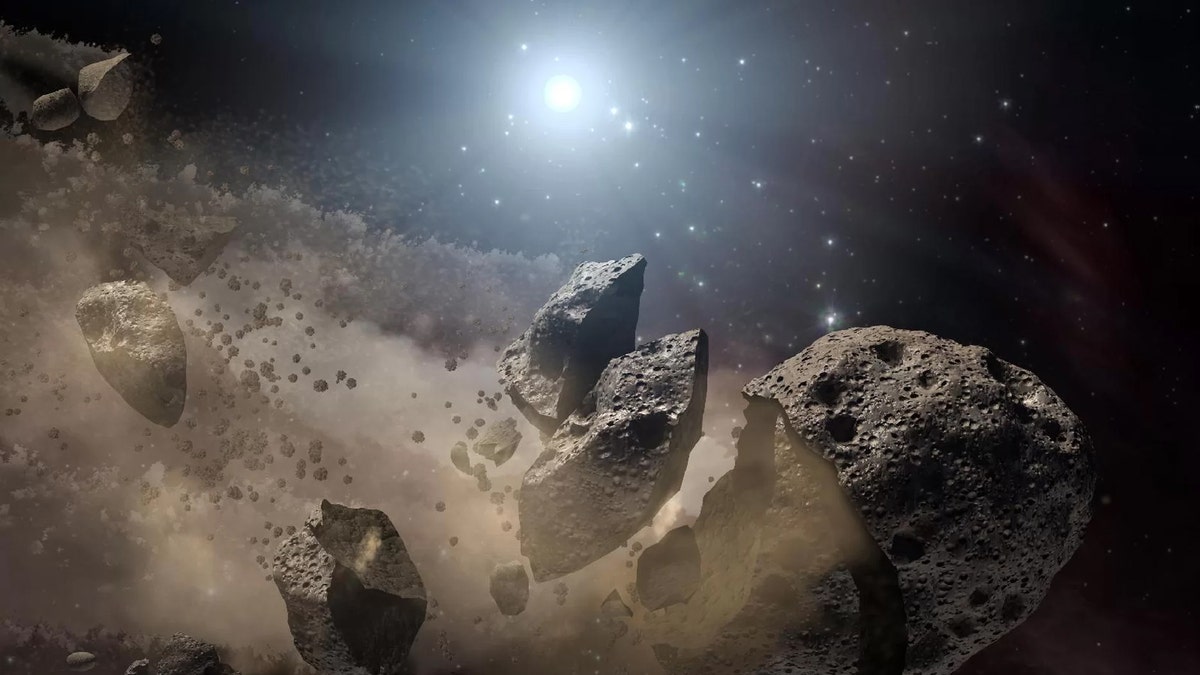
Researchers have found that a family of asteroids that dates back to the solar system's early days. Here is an artist's concept of a broken-up asteroid. The leftover building blocks of the solar system, called planetesimals, were similarly fragmented, and they drifted apart over time. (Credit: NASA/JPL-Caltech)
A "potentially hazardous asteroid" known as 2002 AJ129 is set to fly by Earth at a whopping 67,000 miles per hour next month — but there is no need to worry, scientists say.
The 0.7-mile long body ─ larger than the tallest building on Earth, Dubai’s half-mile high Burj Khalifa skyscraper ─ will rocket past our planet on Feb. 4 by 2.6 million miles, giving it no chance of hitting us.
Potentially hazardous asteroids, or PHAs, are not uncommon. According to a 2013 report on NASA's website, there are over 1,000 PHAs out there and possibly more yet to be discovered.
MASSIVE, 3-MILE-WIDE 'POTENTIALLY HAZARDOUS ASTEROID' WILL ZOOM PAST EARTH TOMORROW
PHAs are defined by NASA as Near-Earth Asteroids "whose Minimum Orbit Intersection Distance (MOID) with the Earth is 0.05 [in astronomical units] or less and whose absolute magnitude is 22.0 or brighter."
One astronomical unit is 149,597,870,700 meters (approximately 93 million miles), or approximately the average distance between the Earth and the Sun.
2002 AJ129 is expected to be the largest and speediest space object to whiz past the Earth in 2018, according to the Atlanta Journal Constitution.
Astronomers almost unanimously agree that no PHA-sized asteroid, particularly those of the near-Earth variety, will hit our planet over the next 100 years. However, Paul Chodas, Paul Chodas, Manager of the NASA NEO Program Office at JPL, said there are 46 that could potentially hit within the next 100 years. "Those are the ones we need to pay attention to and we're tracking them," Chodas told Fox News in a phone interview.
He added that these asteroids have approximately a 1 in 10 million chance of hitting the Earth. If one of this size were to hit us, it could cause some serious damage.
When discussing the 3-mile wide 3200 Phaethon, which flew past Earth in mid-December, Boston University astronomy professor Michael Mendillo told Time that an asteroid of this size "would be this kind of object that would cause a catastrophic collision, should there be one,” before adding that it is highly unlikely.
In addition to the aforementioned 3200 Phaethon and 2002 AJ129, Earth has had some close-calls with giant space rocks in recent months.
In August 2017, a 2.7-mile wide asteroid dubbed Florence passed by Earth at a safe distance of 4.4 million miles, roughly 18 times the distance between Earth and the moon. And in October, 2012 TC4, a space rock estimated to measure between 50 and 100 feet, passed safely past Earth by 26,000 miles and was used to test Earth’s international warning network.
METERORITE'S ORIGINS POINT TO POSSIBLE UNDISCOVERED ASTEROID
Saving humanity
If an asteroid were to ever threaten the Earth, NASA has a plan to fight it off.
In June, the agency unveiled a video using 3-D modeling techniques and one of its supercomputers in an effort to produce simulations on a variety of asteroid impact scenarios.
The work is being done by experts on the Asteroid Threat Assessment Project at the NASA Advanced Supercomputing facility at Ames Research Center in California’s Silicon Valley. The efforts are in conjunction with NASA’s Planetary Defense Coordination Office.
The research has been shared with a number of different parties, including university scientists, national research labs and different government agencies.
The work follows an asteroid collision in 2013 in the Russian city of Chelyabinsk. The blast from the asteroid injured more than 1,200 people and damaged buildings 58 miles away.
Separately, in 2016, NASA opened a new office to track asteroids and comets that come too close to Earth, known as the Planetary Defense Coordination Office (PDCO).
NASA has been studying Near-Earth Objects (NEOs) since the 1970s. According to the PDCO, NASA-funded survey projects have found more than 95 percent of the known catalog of over 15,000 NEOs.
Fox News' James Rogers contributed to this report. Follow Chris Ciaccia on Twitter @Chris_Ciaccia. This story has been updated to note one astronomical unit is 149 billion meters, not miles.




















